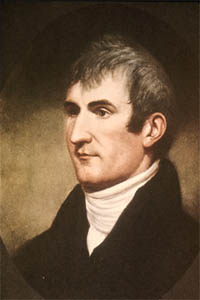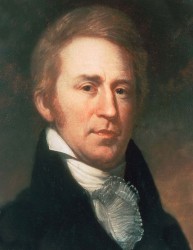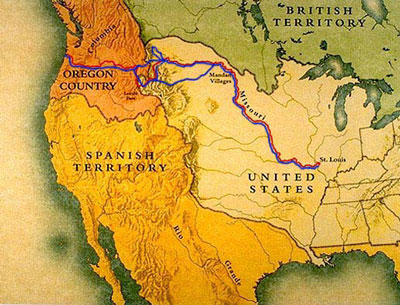My eighth grader’s history textbook allocates half a page to Lewis and Clark. It explains in painfully dull detail how in 1803 President Jefferson sent the expedition to explore the new territory he’d just bought from the French (hello, how about mentioning Napoleon?). Lewis and Clark, the book drones on, were sent to find a route across the Rocky Mountains to the Pacific Ocean, and to collect information on people, plants, animals and geography.
So I thought today I’d touch upon some of the details of the expedition that kids might actually find interesting. For instance, the members of the expedition were practically driven insane by bugs, and they nearly died of starvation, and Lewis got shot in the butt and chased by a grizzly bear. And they were accompanied through the wilderness by a sixteen-year-old Indian girl carrying her infant on her back. Oh yes and pretty much everyone in the party had malaria and dysentery from time to time, and most had syphilis. But arguably the worst part of this arduous journey was the mosquitoes, followed closely by the gnats and ticks.
One other awful yet interesting detail you don’t generally read about in the textbooks: Upon his return, Lewis took his own life by shooting himself and then slashing himself with a razor blade.* (Other historians say he might have been shot by bandits. I think that’s unlikely, but we may never know for sure.)
Meriwether Lewis was a part-time botanist and doctor. William Clark was the mapmaker and boat guy. At the time they set out, few people of European descent had ventured beyond the Mississippi River and–to my knowledge–no European had trekked from East to West all the way to the Pacific Ocean. In fact, most Americans lived within fifty miles of the East Coast.
According to “The Perils of Plant Collecting” by A. M. Martin, Lewis spent 1/3 of his budget on cinchona (from which quinine is derived), mosquito nets, and hog’s lard (with which they had to smear their skin to keep away mosquitoes). Mosquitoes were so thick, people had to eat their food in the smoke of the campfire, and still they managed to swallow dozens of mosquitoes with their food. No wonder they carried 120 gallons of whiskey along. (Says Martin, “Lewis’s motto was ‘Don’t run out of booze until there’s no turning back.’”)
Given that their diet consisted largely of dried strips of wild animal meat, they also popped pills for constipation. They called the pills “thunderclappers.” Their real name was “Dr. Rush’s Bilious Pills.” (Benjamin Rush was a famous doctor at the time of the American Revolution, and signed the Declaration of Independence.) Thunderclappers were high-octane laxatives, made of 60 percent mercury. Even back then, people knew that mercury was terrible for you, and one pill contained enough mercury to kill a person. But the pill passed through a person’s system so quickly, it probably didn’t have much opportunity to be absorbed. Because mercury doesn’t break down, modern scientists have been able to trace the path of Lewis and Clark’s expedition by the amounts of mercury still found in the soil—evidence of where members of the expedition stopped to go to the bathroom. Talk about toxic waste.
___________________
* source: Howard I. Kushner, The Suicide of Meriwether Lewis: A Psychoanalytic Inquiry, The William and Mary Quarterly, Third Series, Vol. 38, No. 3, Jul., 1981, Page 469 of 464-481 also Stephen Ambrose, Undaunted Courage, Touchstone, 1996, page 475


